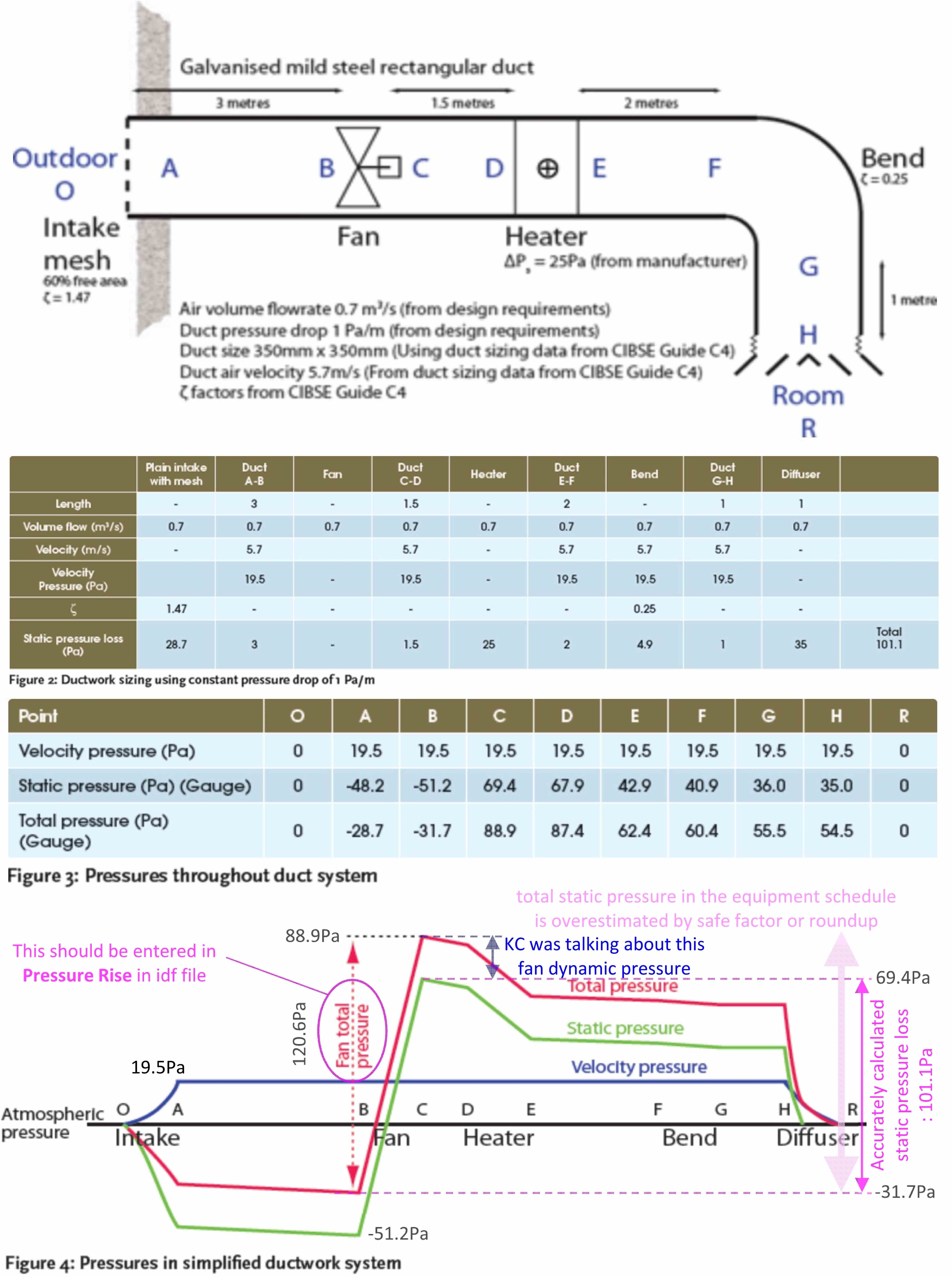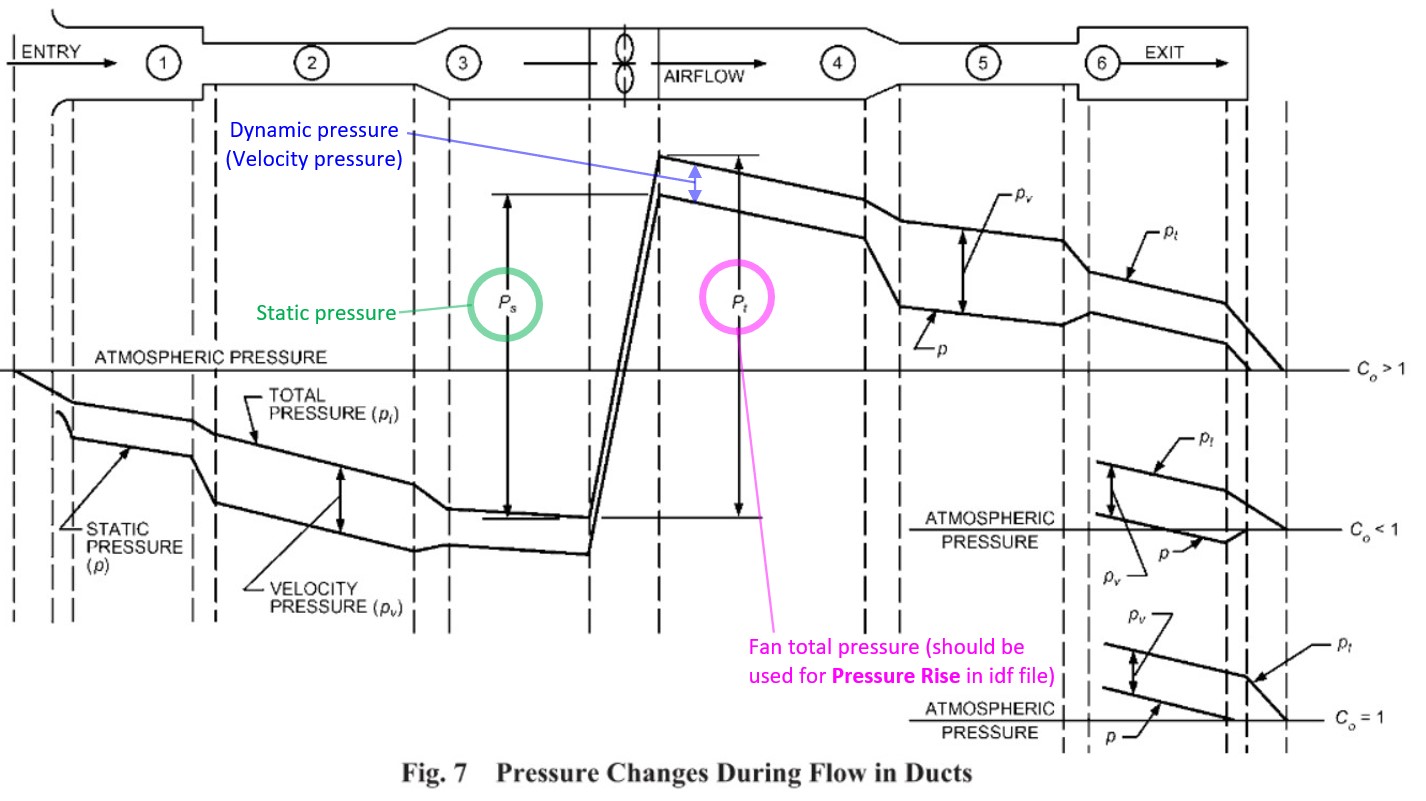First time here? Check out the Help page!
 | 1 | initial version |
A very old question, but I couldn't pass it up. I think @Anna Osborne Brannon 's explanation is not correct. It seems she is confusing "Dynamic pressure" (Velocity pressure) with "Dynamic loss". Dynamic loss which results from flow disturbances in the fitting correlates Dynamic pressure which is the kinetic energy per unit volume of a fluid, but they are differenct concepts.
Short answer: strictly speaking, total pressure (total static pressure + dynamic pressure) shoud be used, but energy modellers use total static pressure case by case. More details below.
In general, the following formula holds:
Fan power consumption [W] = Air flow rate [m3/s] * Fan total pressure [Pa] / Fan total efficiency
EnergyPlus uses the wording Pressure Rise instead of Fan total pressure, but they refer to the same thing.
Fan airflow and rated fan power are always in the fan equipment schedule, but other information available depends on projects.
For constant speed fans, the fan total pressure can be calculated backward by using the rated fan power in the fan equipment schedule as the excess pressure is adjusted with a volume damper i.e. Fan total pressure (=Pressure Rise)[Pa] = Fan Power [W] / Air flow rate [m3/s] * Fan total efficiecny
For variable speed fans,
Pressure Rise in the idf file. It is becasue the external static pressure calculated by MEP engineers is overestimated i.e. a safety factor of around 10% is taken into account or/and it is rounded up in 50Pa or 100Pa increments (e.g. Calculated external pressure + internal pressure = 930Pa → Entered total pressure in the equipment schedule = 1000Pa). On the other hand, dynamic pressure (= 1/2 * ρ * v^2) is normally less than 50Pa. Dynamic pressure is consequently included in the margin of the external static pressure. I think that's why many energy modellers ignore fan dynamic pressure and input only the total static pressure (= internal static pressure and external static pressure) into Pressure Rise field.Pressure Rise in the idf file, but this case is very rare. MEP engineers do not normally calculate fan dynamic pressure because their concern is whether fans can supply air to the farthest room, and because static pressure is the force that pushes air out by overcoming the resistance of ducts.Pressure Rise).I should illustrate. An example of pressure changes in duct. I also attach images below in case the site goes out of link.

In this case, Fan total pressure (= total static pressure + dynamic pressure) of 120.6Pa should be used for Pressure Rise. If the 120.6Pa is unknown, probably the total static pressure in the eauipment schedule or data sheet will be aorund 150Pa (101.1Pa rounded up by 50Pa), which is larger than 120.6Pa.
Another illustation from 2017 ASHRAE Handbook Fundamentals (I added markup).

I/O Reference and Engineering Reference are unkind. They do not cleary describe the difference between static, dynamic and total pressures. Should be updated.
I came up with one more situation. Generally, there are two types of fan efficiency: Fan total efficiency and Fan static efficiency. I think Fan total efficiency is common, but if only the information of fan static efficieny is available, fan total static pressure should be used for Pressure Rise in the idf file, and fan dynamic pressure should not be included i.e.
Fan power consumption [W] = Air flow rate [m3/s] * Fan total static pressure [Pa] / Fan static efficiency
What is confusing is that EnergyPlus seems to use the wording Fan Toal Efficiency not as a counterpart to Fan Static Efficiency, but as a product of Fan motor efficiency and Fan impeller efficiency.
